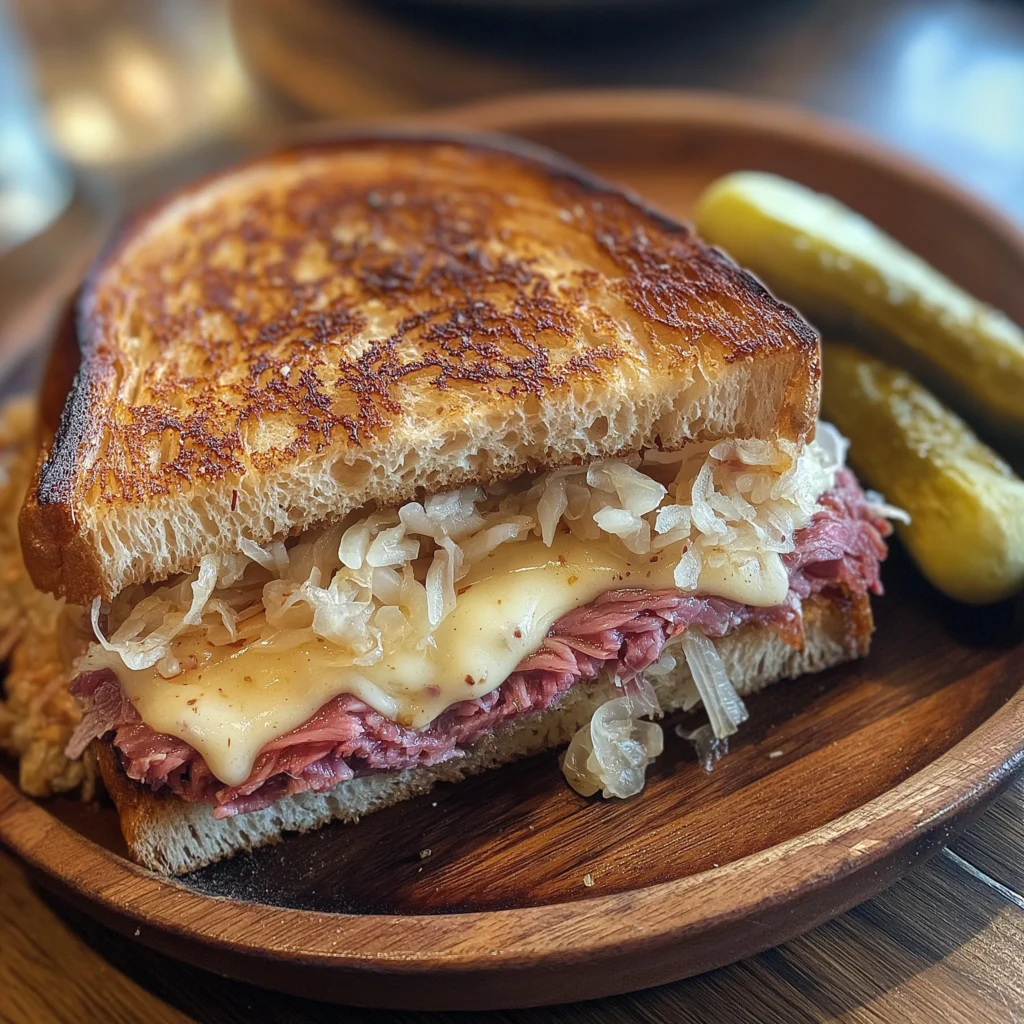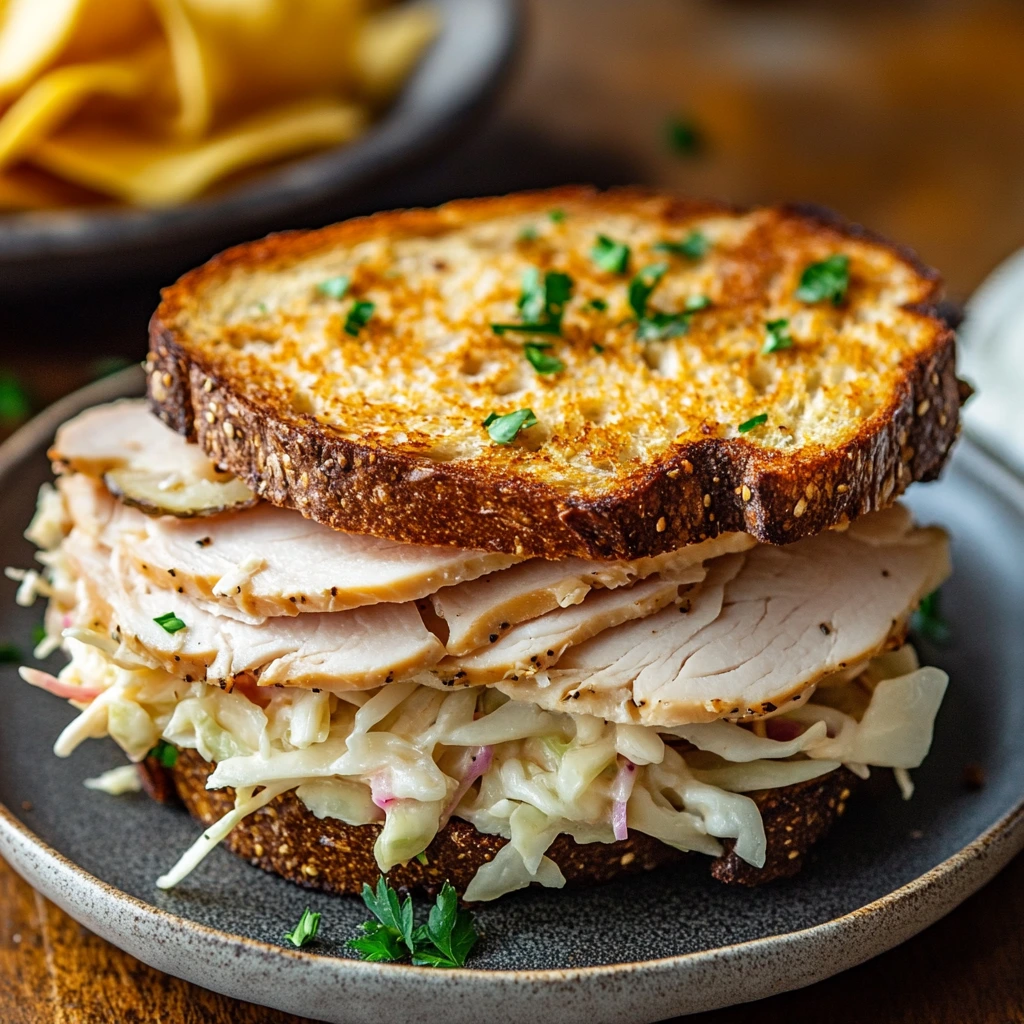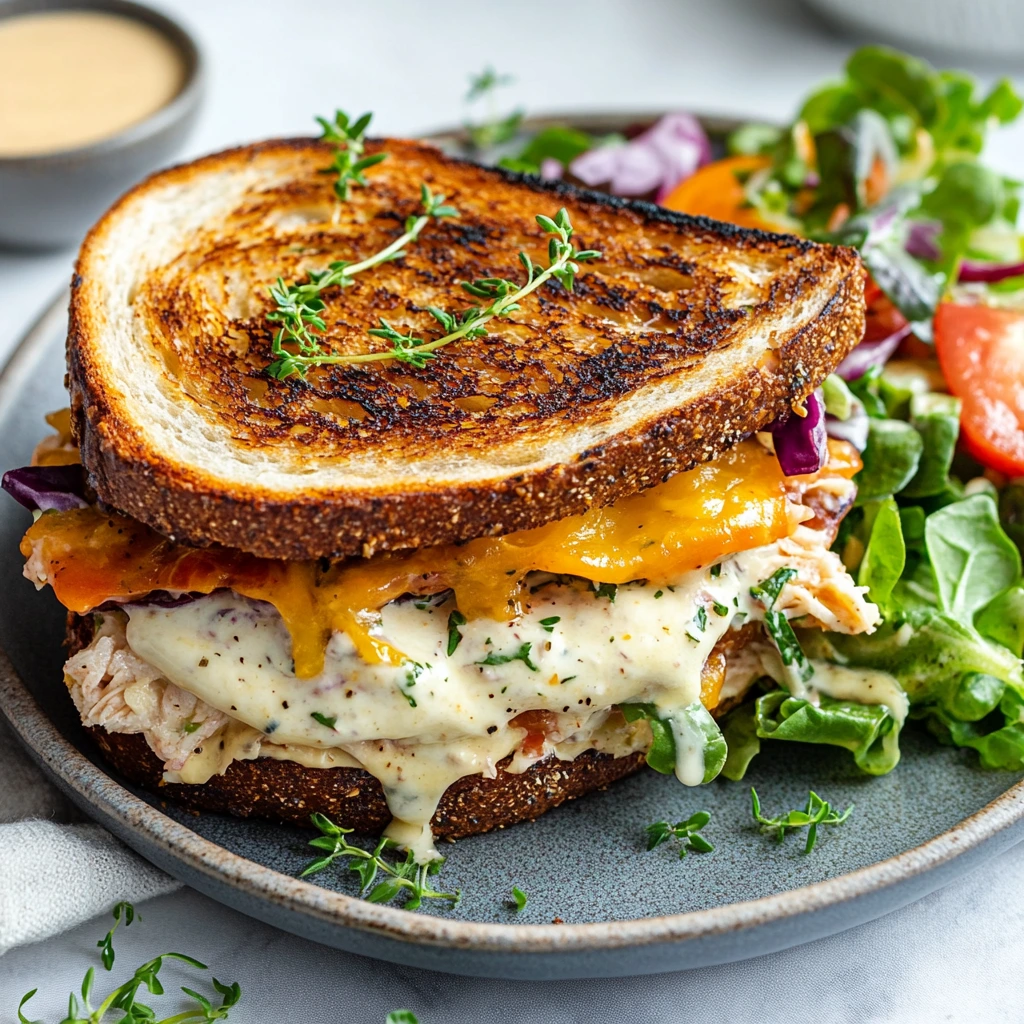Exploring Delicious Variations
The Reuben sandwich is an undeniable classic in the culinary world. With its iconic layers of corned beef, Swiss cheese, sauerkraut, and Russian dressing between two slices of grilled rye bread, it offers a harmonious mix of flavors and textures. But what happens when you remove or substitute sauerkraut? Does it become something entirely new, like the famed Rachel sandwich, or does it simply lose its tangy edge? This article dives into the rich history of the Reuben, its beloved variations, and the intriguing ways it adapts when sauerkraut isn’t part of the mix.

Understanding the Reuben Sandwich
The Classic Reuben: Ingredients and Structure
The Reuben sandwich has long been celebrated as a masterpiece of contrasting flavors. Its mainstay ingredients—corned beef, Swiss cheese, sauerkraut, Russian dressing, and rye bread—combine to create a savory delight. Each element plays a pivotal role: the corned beef provides the meaty, salty base, Swiss cheese brings creamy richness, and sauerkraut delivers that sharp tanginess that cuts through the heaviness.
But it doesn’t stop there! The tangy Russian dressing binds everything together, while the toasted rye bread offers a slightly nutty flavor and a satisfying crunch.
The History of the Reuben Sandwich
The origins of the Reuben sandwich are steeped in culinary folklore. One popular story credits Reuben Kulakofsky, a grocer from Omaha, Nebraska, with inventing the sandwich during a poker game in the 1920s. Another tale claims it was Arnold Reuben, the owner of Reuben’s Delicatessen in New York City, who first served it to a Broadway actress in the early 1900s.
Regardless of where it began, the sandwich quickly grew in popularity. Delis across the United States embraced the Reuben, making it a hallmark of American cuisine.
The Role of Sauerkraut in a Reuben
Sauerkraut isn’t just a filler—it’s a key player in the Reuben sandwich. Its tangy, fermented flavor balances the saltiness of the corned beef and the richness of the cheese. The slight crunch adds a textural contrast that would be sorely missed if omitted. In fact, without sauerkraut, the Reuben takes on a noticeably milder flavor, which might prompt diners to question whether it’s still the same iconic sandwich.
When Sauerkraut Steps Aside
Yet, not everyone is a fan of sauerkraut. Its bold, acidic taste can be polarizing. For those who prefer a less tangy bite, substitutes like coleslaw or even pickles step in to fill the gap. But does this replacement change the sandwich’s identity entirely? Well, that’s the question we’ll explore in the sections ahead.
Traditional Reuben Variations
What Makes a Reuben Without Sauerkraut Different?
When sauerkraut is removed or swapped in a Reuben, the entire flavor balance shifts. Sauerkraut contributes a sharp, fermented tang that cuts through the richness of the corned beef and cheese. Without it, the sandwich feels heavier, lacking that lively acidity. Instead, substitutions like coleslaw or pickles bring their own unique twist. These replacements might result in something entirely different, like the Rachel sandwich, or a simpler, milder take on the classic.
Introducing the Rachel Sandwich: The Sweet Cousin of the Reuben
The Rachel sandwich, often seen as a close relative of the Reuben, is one of the most popular variations. It substitutes coleslaw for sauerkraut, giving it a sweeter and creamier profile. This change transforms the sandwich into a less tangy, more approachable option for those who shy away from strong fermented flavors.
But that’s not all! A Rachel often swaps out corned beef for turkey or pastrami. Turkey provides a lighter flavor, while pastrami adds a peppery kick. The other ingredients—Swiss cheese, Russian dressing, and rye bread—remain consistent, keeping the sandwich rooted in the original’s structure.
Reuben Sandwich Variations Without Sauerkraut
Sometimes, chefs and home cooks omit sauerkraut altogether. These versions are less common but worth exploring:
- Coleslaw Reuben: When coleslaw replaces sauerkraut, the sandwich is rich and creamy but lacks the tangy bite of the original. This variation is often lighter and more refreshing.
- Pickle Reuben: Pickles, another tangy option, bring crunch and a briny flavor. This twist creates a hybrid sandwich that retains some of the Reuben’s boldness while adding a fresh spin.
- Plain Reuben: Simply removing sauerkraut without a replacement results in a pared-down version. While still tasty, it feels less balanced, as the sour element is missing.
Cultural Takes on the Reuben
Across different regions, people have experimented with the Reuben sandwich in creative ways. For instance, in the Midwest, you’ll find a version with pickled green tomatoes replacing sauerkraut. Meanwhile, some delis in New York offer a “kosher-style Reuben” that omits cheese but keeps the other classic elements intact.
Variations of the Reuben Sandwich
Rachel Sandwich: A Sweeter Spin
The Rachel sandwich is the most well-known variation of the Reuben sandwich. Swapping sauerkraut for coleslaw creates a sweeter, creamier flavor profile. This change makes the Rachel a favorite for those who find sauerkraut too pungent. Turkey often replaces corned beef in a Rachel, giving it a lighter, leaner feel. However, pastrami is another popular substitute, lending a smoky and spiced character to the sandwich.
The Rachel keeps the core elements of Swiss cheese, Russian dressing, and rye bread. This balance ensures that, while it deviates from the traditional Reuben, it remains just as satisfying.

International Twists on the Reuben
Beyond the classic and Rachel sandwiches, international adaptations offer unique takes on the Reuben sandwich.
- Montreal Reuben: This version uses Montreal-style smoked meat instead of corned beef. Smoked meat has a subtler spice mix, creating a gentler, smokier sandwich.
- Florida Grouper Reuben: Found in the Sunshine State, this variation swaps corned beef for grilled or fried grouper. It’s a seafood-forward option that uses coleslaw instead of sauerkraut, mirroring the Rachel in flavor balance.
- Midwestern Walleye Reuben: The Midwest adapts the Reuben with its local walleye fish, served on rye bread with melted Swiss cheese and tangy dressings.
These variations demonstrate how the Reuben’s core components—protein, dressing, cheese, and rye bread—can be adapted to suit local tastes and ingredients.
Vegetarian and Vegan Reubens
Vegetarians and vegans haven’t been left out of the Reuben evolution. Creative cooks have reimagined the sandwich with plant-based ingredients:
- Plant-Based Proteins: Tempeh, jackfruit, or seitan stand in for corned beef, providing a meaty texture and flavor.
- Vegan Cheese: Dairy-free cheese alternatives, often made from cashews or soy, melt beautifully to mimic Swiss cheese.
- Sauerkraut Substitutes: Pickled veggies like red cabbage or tangy slaws add the necessary zing without using traditional sauerkraut.
- Dairy-Free Dressing: Vegan Russian or Thousand Island dressing ensures the sandwich remains creamy and cohesive.
These adaptations ensure that everyone, regardless of dietary preference, can enjoy the delicious essence of a Reuben sandwich.

Seafood Reubens: A Coastal Delight
In coastal areas, seafood often takes the place of corned beef in Reuben sandwiches. Here are two popular examples:
- Crab Reuben: Lump crab meat replaces corned beef, paired with Swiss cheese and sauerkraut for a briny, tangy twist.
- Salmon Reuben: Grilled or smoked salmon makes a rich and decadent alternative, complemented by a drizzle of tangy dressing.
These creative variations illustrate how versatile the Reuben can be while still maintaining its roots in hearty, satisfying flavors.
What Is a Reuben Without Sauerkraut Called?
The Identity Crisis of a Reuben Without Sauerkraut
When sauerkraut is removed from a Reuben sandwich, the result is not just a culinary adjustment but also a question of identity. Does it remain a Reuben, or does it become something else entirely? The answer largely depends on the substitution.
If coleslaw replaces sauerkraut, the sandwich is often renamed a Rachel sandwich. The Rachel is widely recognized as the Reuben’s sweeter and lighter counterpart. It retains many of the same ingredients—rye bread, Swiss cheese, and Russian dressing—but its overall profile is distinctly different due to the absence of the tangy, fermented flavor that defines sauerkraut.
What Happens When There’s No Replacement?
If sauerkraut is omitted entirely without a substitute like coleslaw or pickles, the sandwich enters a gray area. Some delis might label it a “corned beef and Swiss on rye,” while others call it a “plain Reuben.” This naming convention, while straightforward, doesn’t capture the spirit of the traditional Reuben, as the tangy balance is missing.
Alternative Names Based on Regional Trends
Naming conventions for a Reuben without sauerkraut can vary by region and creative interpretation:
- Corned Beef Melt: This term highlights the key ingredients—corned beef and melted cheese—without referencing the missing sauerkraut.
- Tang-Free Reuben: Some casual eateries use playful names like this to describe the sandwich’s milder flavor profile.
- Coleslaw Reuben: If coleslaw is used, it’s common to see this name used interchangeably with Rachel, though it’s less traditional.
These creative names reflect the culinary flexibility of the Reuben while acknowledging its deviations from the original recipe.
Why Substitutions Matter
Changing just one ingredient—especially sauerkraut—can drastically alter the flavor and identity of a dish. For the Reuben, sauerkraut is more than a filler; it’s a defining element. Its omission or replacement isn’t just a culinary choice; it’s a reinvention of the sandwich itself.
Preparation Tips for Reuben Variations
Crafting the Perfect Reuben Without Sauerkraut
Whether you’re swapping out sauerkraut or leaving it out entirely, preparing a Reuben sandwich variation takes a bit of finesse. The key is to maintain the sandwich’s signature balance of savory, tangy, and creamy flavors while ensuring the bread is perfectly toasted and the ingredients are evenly layered.
Ingredients to Consider
For a Reuben without sauerkraut, you’ll need to rethink the tangy component. Here’s how to approach substitutions while keeping the sandwich delicious:
- Protein Options: Stick with corned beef for a traditional feel, or experiment with turkey (as in a Rachel) or pastrami for a smoky kick.
- Cheese Choices: Swiss cheese is classic, but mild alternatives like provolone can work for those who want a subtler flavor.
- Tangy Substitutes: Use coleslaw, pickles, or even pickled red cabbage for a milder yet flavorful alternative to sauerkraut.
Step-by-Step Preparation
- Prepare the Ingredients: Thinly slice your protein (corned beef, turkey, or pastrami) and ensure your cheese is ready to melt. If using coleslaw, drain excess liquid to prevent soggy bread.
- Butter the Bread: Lightly spread butter on the outside of the rye bread slices for a golden, crispy finish.
- Layer Strategically: Place a slice of Swiss cheese on one piece of bread, followed by your protein, dressing, and your tangy component (e.g., coleslaw or pickles). Top it off with another slice of cheese before adding the second piece of bread.
- Grill to Perfection: Heat a skillet over medium heat, and grill both sides of the sandwich until the cheese melts fully and the bread turns golden brown.
- Slice and Serve: Let the sandwich rest for a minute before slicing it in half. Serve with a side of pickles or chips for a classic deli-style experience.
Tips for Enhancing Flavor
- Make Your Own Dressing: Homemade Russian dressing or Thousand Island dressing can elevate the flavor. Adjust the sweetness or tanginess to complement your chosen filling.
- Use Fresh Bread: Rye bread with caraway seeds adds a nutty depth, but freshly baked sourdough or multigrain bread can also be a delightful alternative.
- Experiment with Add-Ons: Add a slice of tomato, a handful of arugula, or a sprinkle of pepper for a unique twist that complements your sauerkraut-free sandwich.
Pairing Suggestions
A Reuben variation pairs wonderfully with classic deli sides like potato salad, coleslaw, or a cup of soup. If you’re leaning toward a Rachel or another mild version, a refreshing cucumber salad can add a nice contrast to the richness of the sandwich.
Frequently Asked Questions (FAQs)
What is a Reuben without sauerkraut called?
A Reuben sandwich without sauerkraut is often called a Rachel sandwich if coleslaw is used as a substitute. However, if sauerkraut is omitted entirely without a replacement, it may simply be referred to as a “corned beef and Swiss sandwich” or a “plain Reuben.”
Is a Rachel sandwich healthier than a Reuben?
Typically, Many people consider a Rachel sandwich lighter than a traditional Reuben. This is because turkey or pastrami replaces the heavier corned beef, and coleslaw is less acidic than sauerkraut. However, the calorie content depends on portion sizes, dressing, and preparation methods.
What kind of dressing is used on a Reuben or Rachel?
The traditional dressing for both the Reuben and Rachel sandwiches is Russian dressing. Thousand Island dressing is a popular alternative, offering a slightly sweeter flavor with bits of relish. For a lighter option, consider yogurt-based or vegan dressings.
Can I make a Reuben or Rachel sandwich gluten-free?
Absolutely! Simply use gluten-free rye bread or a similar substitute. Most grocery stores offer gluten-free alternatives that work well with this type of sandwich. Ensure the corned beef and dressing are also gluten-free for a fully compliant meal.
What are some vegetarian alternatives for a Reuben sandwich?
Vegetarians can enjoy a Reuben by substituting the corned beef with plant-based proteins like tempeh, seitan, or jackfruit. Vegan cheese and a tangy slaw made from pickled vegetables can replicate the flavors of sauerkraut and Swiss cheese.
Can I prepare a Reuben sandwich without grilling it?
While grilling is traditional and enhances the sandwich’s flavor and texture, a cold or pan-toasted version is possible. Simply assemble the sandwich with chilled ingredients and toast the bread lightly, if desired, for a quicker alternative.
Conclusion
The Reuben sandwich is more than just a combination of ingredients—it’s a beloved symbol of culinary creativity and comfort. Its layers of corned beef, Swiss cheese, sauerkraut, and Russian dressing on rye bread deliver an iconic blend of flavors and textures. But When you remove or replace sauerkraut, the sandwich transforms into something new, such as the Rachel sandwich or other creative adaptations.
Substituting sauerkraut with coleslaw, pickles, or other tangy elements allows for exciting variations that cater to diverse tastes. From turkey-based Rachels to seafood-filled or vegetarian Reubens, the sandwich remains endlessly versatile. Even without sauerkraut, its essence as a hearty, flavorful deli classic endures.
As you explore Reuben variations, remember that the best version is the one that satisfies your taste buds. Whether you stick to tradition or try innovative twists, these sandwiches offer a little something for everyone. Now, it’s time to grab your ingredients, fire up the skillet, and enjoy your personalized take on this timeless favorite. Bon appétit!

